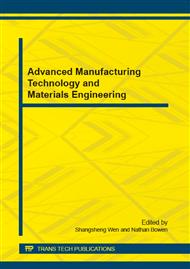p.9
p.17
p.21
p.29
p.33
p.41
p.45
p.51
p.56
Evaluation of Binary System (NaI-Na3PO4) Solid Electrolyte and Performance of Sodium Battery
Abstract:
A Na–ion conducting solid electrolyte system was prepared by using ball milling and sintering method. The electrical conductivity study was carried out as a function of NaI concentration by Electrical Impedance Spectroscopy technique and the maximum conductivity of (1.02±0.19)×10-4 S cm−1 at room temperature was obtained for the composition 0.50 NaI:0.50 Na3PO4. Further characterization was performed by using and Infrared (FTIR) technique. From FTIR spectra, the variation in the peak intensity and shifting is observed due to the presence of P–O and PO43− bands that had been shifted indicating changes in polyhedral structure which in turn led to the formation of conducting channel by corner sharing or through edges. The ionic transference number was found in the value of 0.92 which suggests that ions are the charge carriers. The optimum composition with the highest conductivity of the sample considered as a good candidate to be used as solid electrolyte in solid state sodium battery. The sodium battery with configuration: Na/NaI–Na3PO4/V2O4 was tested by the discharged characteristic at a current of 1.0 μA. The solid state sodium batteries exhibited a discharge capacity of 144mAh/g.
Info:
Periodical:
Pages:
33-40
Citation:
Online since:
December 2014
Authors:
Price:
Сopyright:
© 2015 Trans Tech Publications Ltd. All Rights Reserved
Share:
Citation:


